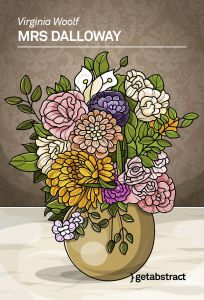
Mrs Dalloway
- Novel
- Modernism
What It’s About
Life in Pieces
Consider an upper-class matron who is planning a party and a suicidal war veteran who sees visions of his dead commanding officer. This unlikely character pairing forms the heart of Virginia Woolf’s modernist masterwork, Mrs Dalloway. As Clarissa Dalloway goes about the events of her day, intrusions from her past – particularly, the re-emergence of her ex-lover Peter Walsh – disrupt her peace of mind about her life and marriage. Meanwhile, the shell-shocked Septimus Smith fights a different kind of battle with memory, one that his wife worries he won’t be able to win. Woolf’s brain-teasing experiments with plot structure, perspective, and stream-of-consciousness narration embody the unrest and fragmentation of British society and culture in the post-World War I years. But more than that, they transform an otherwise straightforward, day-in-the-life sketch of seemingly disparate characters into a poignant study of the effects of the trauma, the effects of memory, the meaning of death and the beauty of being alive.
Summary
About the Author
Virginia Woolf, born Adeline Virginia Stephen, was born on January 25, 1882 in Kensington, London. Virginia and her three full siblings (Thoby, Vanessa and Adrian) shared the family home with the children from Sir Leslie Stephen and Julia Prinsep Stephen’s first marriages (Laura, George, Gerald and Stella). Though Virginia wasn’t sent away to school, the Stephens’s social connections and immense library offered her a rich education. The unexpected death of Julia Stephen in 1895, coupled with sexual abuse by her half-brothers, blighted Virginia’s once happy childhood and led to the first of her nervous breakdowns. Following her mother’s death, Virginia studied at the Ladies’ Department of King’s College. There, she met a group of feminists who would influence her life and writings (notably, her 1929 essay “A Room of One’s Own”). Stella’s death in 1987 and Sir Leslie’s in 1904 sparked subsequent mental collapses. In 1911, Virginia and Adrian purchased a house in Bloomsbury and formed the Bloomsbury Group. One writer in the group, Leonard Woolf, fell in love with Virginia, and the two married in 1912. Virginia struggled with her mental health throughout the 1910s. After completing her first novel, The Voyage Out, she made her first suicide attempt in 1913. She remained incapacitated until 1915, when she began a new novel, Night and Day. The Woolfs founded their famous Hogarth Press in 1917, and Virginia published her first experimental novel, Jacob’s Room, in 1922. That same year, Virginia began a romantic affair with Vita Sackville-West. Later novels, including Mrs Dalloway (1925), To the Lighthouse (1928), Orlando (1928) and The Waves (1931), continued to challenge traditional literary conventions. The onset of World War II upset Virginia’s fragile mental state once again. As she finished Between the Acts (1941), she fell into a depression. On March 28, 1941, she wrote a note to Leonard confessing her fear that she was once again going mad. She then left the house, filled her coat pockets with stones and drowned herself in the River Ouse at age 59.







Comment on this summary